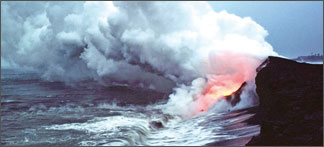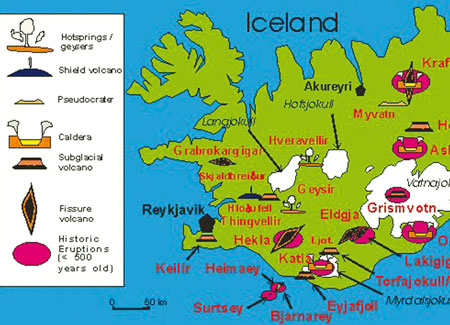|
Iceland:
Land of Ice and Fire
 A
nation that became a 'hot' topic recently, not for its scenic beauty or
the high literacy rate of its people, but for geological reasons, its
volcanic activity, is Iceland. When a volcano with a jaw-breaking name -
Eyjafjallajokull suddenly became active, after 200 years and started to
spew ash in March this year, the attention of the entire world was
focussed on this European island nation. Eyjafjallajokull's outburst had
an impact on many countries including our little nation because the ash
cloud in the skies over Iceland resulted in that area being declared a
'no fly zone'. Many flights were cancelled and passengers were left
stranded. The volcanic activity did not stop for some time,with
Eyjafjallajokull spewing out ash in sporadic bouts till around last
month, impacting the lives of the Icelandic people and the activities of
the airline industry especially in many parts of Europe. A
nation that became a 'hot' topic recently, not for its scenic beauty or
the high literacy rate of its people, but for geological reasons, its
volcanic activity, is Iceland. When a volcano with a jaw-breaking name -
Eyjafjallajokull suddenly became active, after 200 years and started to
spew ash in March this year, the attention of the entire world was
focussed on this European island nation. Eyjafjallajokull's outburst had
an impact on many countries including our little nation because the ash
cloud in the skies over Iceland resulted in that area being declared a
'no fly zone'. Many flights were cancelled and passengers were left
stranded. The volcanic activity did not stop for some time,with
Eyjafjallajokull spewing out ash in sporadic bouts till around last
month, impacting the lives of the Icelandic people and the activities of
the airline industry especially in many parts of Europe.
Fresh fears have been expressed about the possibility of a worse
disaster from volcanic activity in Iceland. So, let's check out some
interesting facts about this land of ice and fire.
Most of you must be familiar with what a volcano is, even though no
such activity has taken place in our country. We have seen and heard
about volcanic activity on television and motion pictures, with the tale
of Pompeii, which was buried in lava when Mt Vesuvius exploded in August
AD 79, being one of the most striking incidents. Fortunately no such
disaster has taken place in the recent past, but scientists claim that
volcanic activity is on the increase, not only in Iceland, but also
elsewhere.
The volcanic activity in Iceland however is different to that of
Mount Vesuvius because Eyjafjallajokull is only spewing ash, not hot
lava. Many volcanoes such as Mt. St. Helens and Mt. Etna which erupted
within the past few decades, spew out hot lava from the core of the
Earth, destroying vast areas of land and affecting the lives of people.
Iceland - the name suggests that it's a cool place, totally covered
in ice. It's therefore hard to believe that volcanoes exist in this
place,but some of you may not be aware that Iceland is an oceanic island
which owes its existence to a volcanic hot spot. Situated on the
Mid-Atlantic Ridge, the dividing line between the Eurasian and North
American continental plates, Iceland is Europe's second largest island
(following Great Britain) and the World's 18th largest island.
With a land area the size of Virginia in USA and a population of
260,000 people, Iceland gained soveriginity from Denmark in 1918 and
complete independence in 1944. The first settlers are said to be Vikings
(in the 9th century AD). Iceland established its own parliament in .930
AD.
What you will be amazed to learn is that there are 35 active
volcanoes on and around Iceland. The three major volcanoes are Hekla,
Katla and Grimsvotn, which lie along the boundary.
Compared to the island's past volcanic activities, Eyjafjallajokull's
activity which has resulted in filling the skies above northern Europe
with ash, is considered to be mild. In fact, it is not
Eyjafjallajokull's activity that is the major concern but the
possibility of another volcano, one of the most feared volcanoes,
becoming active in the near future. Geologists claim that historically
Eyjafjallajokull's eruptions have preceded eruptions by Katla which is
dubbed as one of the 'Angry Sisters.'
Before we check details of the Angry sisters, let's first look into
the volcanic activities of Eyjafjallajokull which means 'island mountain
glacier'. Eyja means island, Fjall means mountain and Jokull means
glacier. It is the mountain with the glacier visible from or around the
Western islands.
After being dormant for nearly 200 years since its outburst in 1821,
Eyjafjallajokull suddenly woke up from her slumber to flex her muscles
on March 21 this year.
Nearly 600 people fled their homes and air traffic too was affected.
Then again it reacted with another bout of ash on April 14 and also in
May - filling the northern European skies with a heavy cloud of ash. Its
previous eruption is said to have lasted more than a year, from December
1821 to January 1823.
Iceland, the land of ice and fire with her numerous volcanoes has
always been a tourist attraction; many visit the country to catch a
glimpse of the pillars of smoke, ash clouds or the spectacular lava
flows from its volcanic activities.
Not all volcanic activity in Iceland are mild and spectacular events
to watch because some, especially the eruptions of the 'Angry sisters'
could spell disaster.
Who are these so-called Angry sisters? Katla and Hekla. Katla located
under the vast Myrdalsjoekull glacier is one of the highest volcanoes in
Europe standing at 1,512m (4,961 ft) with a crater ten kilometres in
diametre. Historically it tends to erupt every 40-80 years.
Its last major eruption had taken place in 1918 with a smaller
eruption in the 1950s. Geologists are concerned that Katla which lies 15
miles to the east of Eyjafjallajokull, could erupt anytime now as many
of Iceland's volcanoes seem to be stirring into activity.
Katla has a crater which is filled with ice that is more than 2,000
ft thick and if it erupts, all this ice would melt, leading to massive
flooding.
The other Angry sister is Hekla which is also close to a major
eruption. At 1,490 mt. Mount Hekla was believed to be one of the
gateways to hell in the Middle Ages.
 It
is Iceland's most active volcano and has erupted over 20 times since AD
874. Geologists and volcanologists have reported that snow is melting
again so, there is a strong possibility that it could erupt in the near
future. They are of the view that Iceland could be at the start of a
surge in volcanic activity with many eruptions to come.Apart from Hekla
which is potentially close to an eruption, two other volcanoes which are
also larger than Eyjafjallajokul are potential threats. They are
Grimsvotn and Askja. It
is Iceland's most active volcano and has erupted over 20 times since AD
874. Geologists and volcanologists have reported that snow is melting
again so, there is a strong possibility that it could erupt in the near
future. They are of the view that Iceland could be at the start of a
surge in volcanic activity with many eruptions to come.Apart from Hekla
which is potentially close to an eruption, two other volcanoes which are
also larger than Eyjafjallajokul are potential threats. They are
Grimsvotn and Askja.
Grimsvotn which lies under the huge Vatnajokull glacier is linked to
the massive Laki fissure volcano whose 1783 eruption had released so
much volcanic ash into the atmosphere that it cooled the entire northern
hemisphere for nearly three years.
The low temperatures had led to crop failure and famines that killed
two million people. It had helped trigger off the famous French
Revolution.So, are we heading for another such era with all the activity
that's taking place in this region? Let's fervently hope not.
Facts and pix- Internet
*******
[Some selected major eruptions]
 Geologists
and scientists have reconstructed a timeline of 205 eruptions spanning
1,100 years. They have observed that these eruptions have taken place in
regular cycles and (hold your breath) the relatively quiet period that
had dominated the past 50 years is now coming to an end. Geologists
and scientists have reconstructed a timeline of 205 eruptions spanning
1,100 years. They have observed that these eruptions have taken place in
regular cycles and (hold your breath) the relatively quiet period that
had dominated the past 50 years is now coming to an end.
Let's see what the outcome of some past eruptions were...
* Grimsvotn Haki erupted in 1783-1785
A 300 sq km area had been inundated and the sulphur dioxide and
hydrogen fluoride emitted from it had killed 9,000 people.
The low temperatures that followed cooled the entire northern
hemisphere. (1) Result was famine and death.
Grimsvotn erupted again in 1996 causing a glacial burst and a flood
that resulted from it washed away Iceland's main ring road.
Its 2004 eruption sent ash up to 12 km into the air, some of it
landing in Norway, Sweden and Finland.
* Hekla - 1947-1948. Its eleven month long eruption resulted in a
major lava flow. About 24,000 tons of carbon dioxide was emitted. It has
erupted 20 times since AD 874.
A minor eruption occured in 2000.
* Eldfell - 1973 erupted for 7 months on the island of Heimaey.
*******
[ Fast facts about the country]
* Official language of Iceland - Icelandic (North Germanic language)
from Old Norse. English is widely spoken as the second language.
* Icelanders' Sagas are the country's best known classical works of
literature. The sagas were written in the 12th and 13th centuries which
was known as the golden age of literature in the country.
* Main traditional sport is called Gilma, a form of wrestling which
originated in Medieval Times. Popular sports are football, track and
field, handball (which is referred to as a national sport and
basketball.
* Iceland has three national parks. About 67 per cent of the land
area of the country is tundra while lakes and glaciers cover 14.3 per
cent of the area.
* Island of Surtsey which formed in 1963 as a result of offshore
volcanic activity is the southern most part of Iceland. Volcanic
eruptions had started 130 mt (426 ft) below sea level on November 14,
1963 and lasted till June 5, 1967. It is the youngest island.
* There are two types of islands, continental islands and oceanic
islands. A majority of oceanic islands are volcanic, and Iceland is one
such island.
* There are many mammals such as the Arctic fox, mink, mice and
reindeer in Iceland. The Iceland sheepdog, the Iceland horse, and
Icelandic sheep are also a part of its fauna. No reptiles or amphibians
are found.
* The Northern birch is native to Iceland.
* Most of the country's cuisine is based on fish, lamb and dairy
products. |

